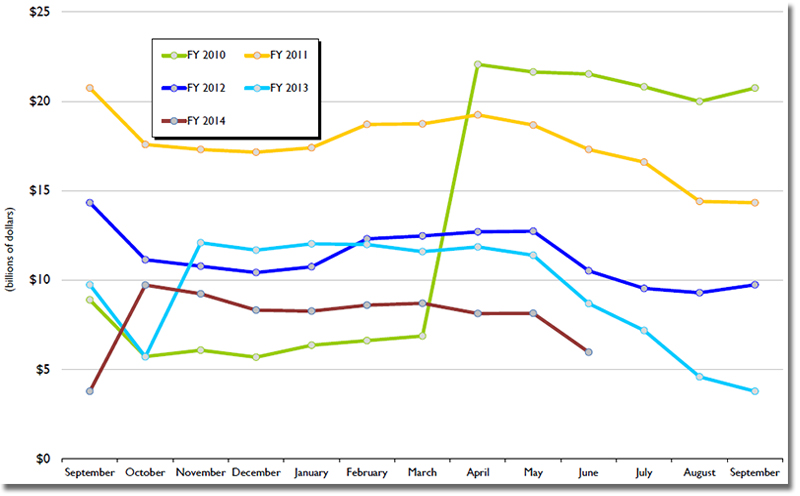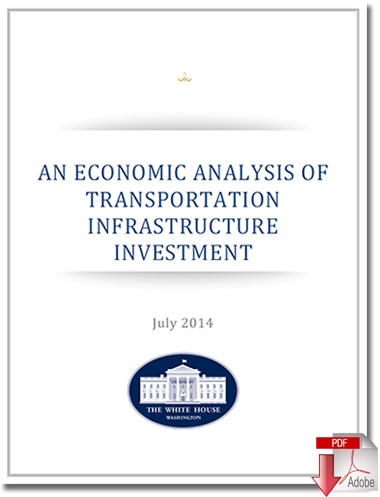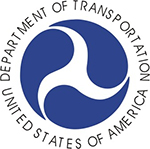Economic Analysis of the Transportation Infrastructure Investment

The federal government's current level of spending on transportation projects is about $50 billion, which infrastructure advocates say is barely enough to maintain the current state of the nation's roads and bridges.
The White House released a new report from the Council of Economic Advisers and National Economic Council on the long-term economic benefits of transportation investment and why conditions in the infrastructure sector are ripe for innovation, with new technologies and approaches promising significant gains in productivity, efficiency, and resilience.
The President has been clear that we need to improve our infrastructure and rebuild our roads and bridges in a smarter, more responsible way, while supporting millions of jobs.
The President will continue to urge Congress to act to avoid a lapse in funding of the Highway Trust Fund, which will go insolvent as early as August – putting numerous active projects at risk.
This week Congress will consider a solution to avoid that scenario.
In addition to the report, the White House released an interactive transportation map detailing the condition of and consequences for each state’s roads and bridges as well as the jobs that would be put at risk, if Congress fails to act.
Highway Trust Fund: Questions & Answers
Background: In 1956, the federal highway program was created to build a coast-to-coast 42,000-mile network of interstate highways to connect all major cities in the country. To pay for this program the government instituted a “user fee” in the form of a federal gas tax. Once the network was completed in the mid-1980s, the highways and the fuel tax were to be handed over to the states to manage. Congress, however, grew accustomed to the influx of revenue and the spending it enabled. The program has since been periodically reauthorized through highway bills, expanding on each occasion, and today, the fuel taxes motorists, truckers, and bus drivers pay are spent on a variety of measures well beyond the scope of roads and bridges, very few of which address the actual problems facing motorists.
Status: The Highway Trust Fund has been depleted and lawmakers are now seeking $10 billion to bail it out to continue transportation spending at current unsustainable levels.
What is the Highway Trust Fund (HTF)?
The Highway Trust Fund is a federal transportation fund filled with revenue collected from federal fuel taxes—18.4 cents per gallon of gasoline and 24.4 cents per gallon of diesel fuel—and related fees. Congress draws from the HTF to fund a multitude of spending measures, from highways and bridges to a series of local “livability” programs to mass transit such as buses and subways.
Why is another highway bill coming up right now?
At the end of fiscal year 2014, the current federal highway bill will expire. In the meantime, however, spending out of the HTF is so disproportionate to what drivers contribute in fuel taxes that Congress is faced with having to ratchet back spending or bail out the fund at taxpayer expense. Congress is considering a $10 billion bailout that will refill the HTF temporarily and extend all transportation programs into 2015.
Why is the HTF out of money?
The current law governing the federal highway and transit programs, set in effect by the last highway bill, is called MAP-21: Moving Ahead for Progress in the 21st Century. MAP-21 authorizes annual spending well above the revenue the HTF will collect and funds a host of parochial projects that have no business being handled at the federal level. This practice has allowed HTF expenditures to far eclipse the amount of revenue collected from fuel taxes.
One example of a trust fund spending diversion is mass transit. Transit use, which is mainly concentrated in just six cities (the municipalities of Washington, D.C., New York, Boston, Chicago, Philadelphia, and San Francisco), received 17 percent of total federal user fees in 2010, even though its share of the nation’s surface travel amounted to roughly 1 percent and transit users pay nothing into the HTF. Other diversions included programs such as nature trails and landscaping, environmental study and mitigation efforts, community preservation, ferry boats, and bicycle paths.
The lack of spending prioritization, coupled with egregious federal intervention into local community projects, has drained the HTF to the point of insolvency. (Past transfers from the General Fund of the Treasury have totaled over $50 billion since 2008.)
What are the current proposals to refill the HTF? Will they work?
Senators Bob Corker (R–TN) and Chris Murphy (D–CT) have proposed hiking federal gas taxes by 12 cents per gallon. This would raise the gas tax to 30.4 cents per gallon of gasoline and 36.4 cents per gallon on diesel (on top of state fuel taxes).
In the House, Ways and Means Committee Chairman Dave Camp has unveiled a $10.9 billion plan to extend transportation funding through May, 2015 that would refill the HTF through a three-fold approach:
- Raise $6.4 billion over the next decade through “pension smoothing”—allowing companies to cut back on their payments to employees’ pension funds, thereby subjecting more profits to taxation
- Raise $3.5 billion in 2024 by extending customs and user fees by another year (a scorekeeping gimmick that was already used in the flawed Ryan-Murray budget agreement)
- Raise $1 billion transferring it from a fund used to clean up leaking underground storage tanks to the HTF
Neither of these proposals would make any real reforms to the way tax dollars are allocated under the current federal highway program. The Corker-Murphy gas tax hike would perpetuate a broken system at greater expense to motorists. The Camp proposal would achieve the same effect to the detriment of taxpayers in general, employing routine Congressional budget gimmicks to offset irresponsible spending measures. Finding more money for bureaucrats to waste on our behalf is not a solution.
What happens if the HTF runs out of money? Won’t the U.S. face a transportation crisis?
Gas tax revenues will still flow into the HTF and be paid out for transportation projects. The U.S. Department of Transportation would simply have to slow down payments to the states.
Lawmakers are fond of sounding the alarm bells about what will happen to the national transportation infrastructure if states have to face a reduction in federal funding. Secretary of Transportation Anthony Foxx has said states will see on average a 28 percent cut in funding from the HTF. This figure is shockingly misleading, however, as the overwhelming majority of highway funding comes from state and local governments, not the federal government. The 28 percent figure is missing context. The “crisis” reduction Obama and many Congressmen are threatening about amounts to a 7 percent cut in overall transportation spending. This will not devastate the country’s surface transportation, and states will reserve autonomy to prioritize which projects are essential and which have been forced on them by the federal government.
If Congress does not act, will the federal interstate shut down?
No. The federal interstate will be open for travel, and construction will largely continue although plans for some additional projects may be scaled back.
President Obama says reauthorization is simple: “We’re just building roads and bridges like we’ve been doing for the last, I don’t know, 50, 100 years.” What is the problem with Washington helping states with transportation decisions?
Heritage Foundation Policy Analyst Emily Goff hits the nail on the head:
- Spending priorities are determined more by politicians appeasing special interests than local needs or consumer choices. And the federal regulatory burden delays projects and smothers state and private-sector innovation.
- When car and truck drivers pay the 18.4 cents per gallon federal gas tax (24.4 cents per gallon for diesel) at the pump, they expect better roads and less traffic congestion in return. Instead, Washington diverts more than 25% of that money to subways, streetcars, buses, bicycle and nature paths, and landscaping, at the expense of road and bridge projects.
This cycle of DC-centric policy choices is bad for the country’s infrastructure and abusive to the U.S. taxpayer.
Is there any opportunity for real reform?
Yes. To take away the need for periodic highway bills completely, Rep. Tom Graves (R-GA) and Sen. Mike Lee (R-UT) have introduced a new way forward in theTransportation Empowerment Act (H.R. 3486/S. 1702). This bill would return the highway program to local control, empower local and state governments to carry out projects that best serve their interests, and enhance the efficiency of how money is spent on the nation’s transportation.
The federal fuel tax would be reduced from 18.4 cents per gallon of gasoline to 3.7 cents, and from 24.4 cents per gallon of diesel to 5 cents, over a five-year period—limiting the user fee to fund only appropriate federal activities and forcing an end to governmental waste and ineptitude.
States and localities would be free to set whatever transportation policies they deem necessary and pay for projects in a way that works best for them without the costly and cumbersome hurdles imposed by the federal government.
Call to Action: Sentinels should encourage their members of Congress to resist the business-as-usual bailout of the Highway Trust Fund. This system has been broken for far too long and the nation’s motorists have suffered as a result. Conservatives should insist that the HTF live within its means in the near-term and that Congress pass the Transportation Empowerment Act to introduce real reforms to future transportation policy.
Source: Zack Slingsby, Heritage Action for America, The Forge Blog
Related (video): Jon Stewart Tackles the Highway Funding Fight















